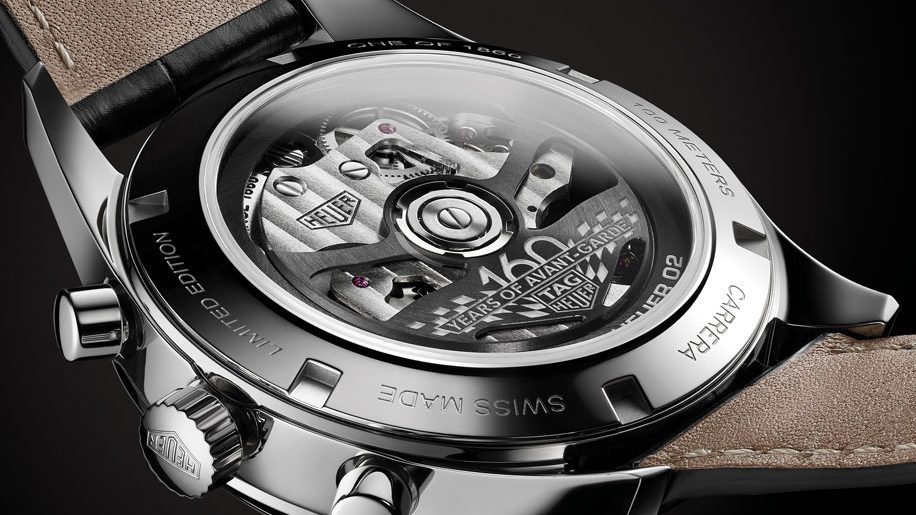
The latest Carrera is a celebration of 160 years of Tag Heuer, says Chris Hall.
As we entered the Twenty-Twenties, my social media feeds were packed with tedious posts summarising people’s achievements over the past ten years (the obligatory then-and-now selfies, plus a list of suitably wry boasts or laments). There was also a stream of new watches as some of the largest brands convened in Dubai to parade their latest creations. It inspired me to look at Tag Heuer, which has covered more ground than most since 2010.
Mid-market, high-volume brands do tend to cycle through designs, strategies and ideas quite quickly – essential when you’re in the business of being a lot of things to a lot of people – but even so, a re-read of its 2010 brochure is a look back to a very different time.
Brand ambassadors Leonardo DiCaprio, Lewis Hamilton and Tiger Woods have all moved on, and Tag Heuer’s motoring tastes have moved with the times, too – out with the gas-guzzling Mercedes-McLaren SLR hypercar tie-in, in with a sponsorship deal for Porsche’s all-electric Formula E team. Gone, and not overly lamented, are the fantastically expensive “luxury” mobile phones; in their place, Tag Heuer has committed more wholeheartedly to smartwatches than any other Swiss brand. Despite not winning the hearts of watch purists, the Tag Heuer Connected watch, launched in 2015, seems to be selling, and this spring a second-generation model is rolling out.
There have been big changes to its traditional watches, too. A decade ago, the Grand Carrera sat proudly at the top of the collection. Modelled by a youthful Hamilton, it revelled in a techy, modern aesthetic and saw the brand tinker with dials that displayed time in flashy new ways – on linear displays, or in semicircular cut-out windows with chunky surrounds decorated to look like brake calipers.
Across the board, Tag Heuer was doing its best to epitomise the “avant-garde” of its name (the “Tag” stands for Techniques d’Avant Garde, the Saudi conglomerate that purchased the Swiss watch brand Heuer in 1985), with brave new designs in its Aquaracer, Link and Monaco ranges.
When you look at the catalogue of 2010, ironically, what really dates it is the lack of “heritage” models, which since then have become essential at all major brands. Tag Heuer now offers two distinct streams of products – forward-looking watches for its younger audience, and throwback models aimed at more mature buyers drawn by its historic associations with the likes of Steve McQueen and Ayrton Senna.
The Grand Carrera is no more – it proved too modish to carve out a lasting place in the brand’s canon – but its replacement, the Carrera Calibre Heuer 01, revels in high-tech once again. Since 2010, Tag Heuer has also revived three storied chronographs from its archives: it resurrected the Monza, took the Monaco back to its roots, and made great efforts to put the Autavia, almost forgotten in the 2000s, back on the map.
Heritage edition
So what of the brand’s flagship model, its most enduring and popular chronograph, the Carrera? Introduced in 1963, it has been synonymous with Heuer and Tag Heuer for nearly 60 years. In 2010, Tag Heuer was proudly unveiling a new movement for the Carrera as the brand celebrated its 150th anniversary: the movement, a Swiss-made clone of a Seiko chronograph movement that it named Calibre 1887, was installed in designs that blended contemporary and classical influences.
Descendants of those watches still populate the 2020 line-up but don’t get as much attention these days. Instead, as the brand marks 160 years on the clock, it seems almost inevitable that it would celebrate with a new addition to its Heuer Heritage collection – a Carrera created in direct homage to the first 1960s model. Entitled the Carrera 160 Years Silver Limited Edition and on sale from June, some 1,860 will be made, costing £5,295 each.
It’s everything Tag Heuer’s most loyal fans would want (if pricier than might have been expected) – a 39mm case with the retro “Heuer” logo on the dial; a face whose subdials at three, six and nine o’clock are unspoilt by a date window; and tastefully monochromatic looks save for the beige luminous material on the hands and hour markers (it doesn’t glow beige, thankfully).
You could, at this point, conclude how depressing it is for traditionalists – myself included – to prefer it when brands exist in some kind of stasis, forever reliving a gilded past. And it’s true, where Tag Heuer is concerned, that I favour the vintage designs.
But it’s not as simple as that. Whereas the brand’s novel creations of a decade ago relied on outsourced or imitated movements, today’s 160 Years Carrera uses a genuinely in-house chronograph calibre, introduced over the past few years and boasting specs that are hard to match: 80 hours of power reserve; a construction that uses a column wheel and vertical clutch – hallmarks of smoother, sharper, more sophisticated movements; and, best of all, a design that allows the use of the period-correct 3-6-9 dial layout. So in ten years, the Carrera has improved in both looks and capability: I call that progress.












